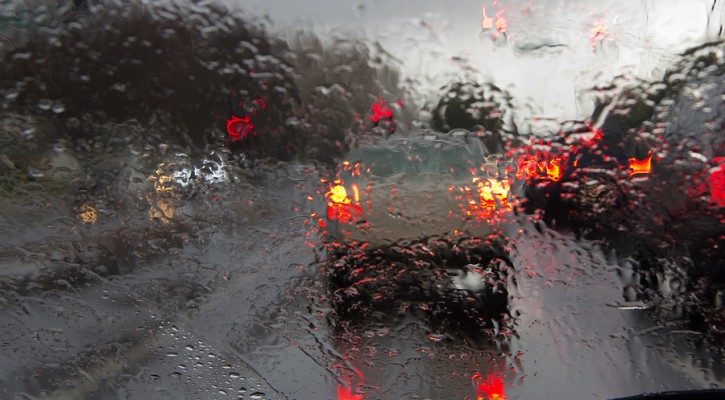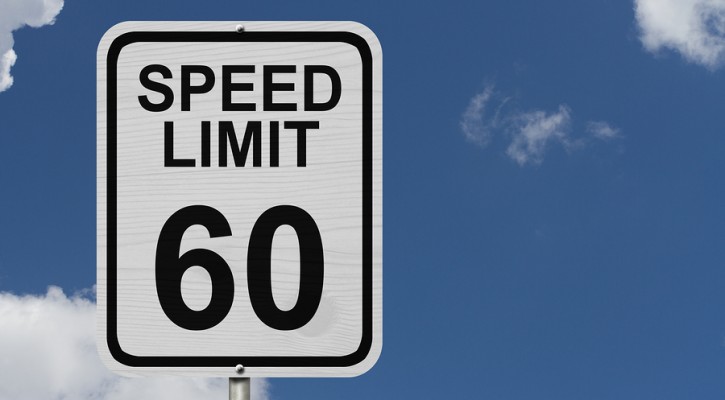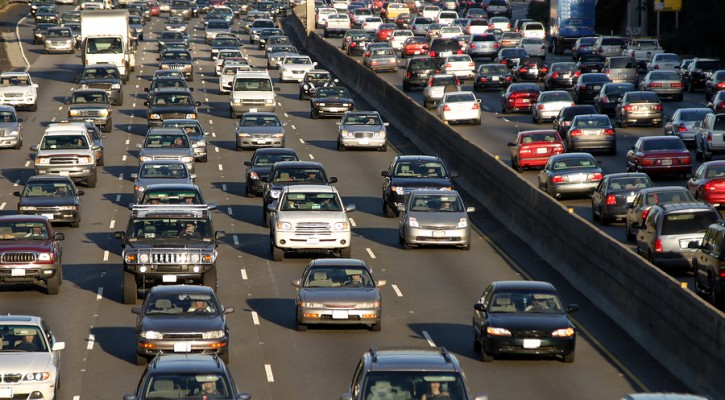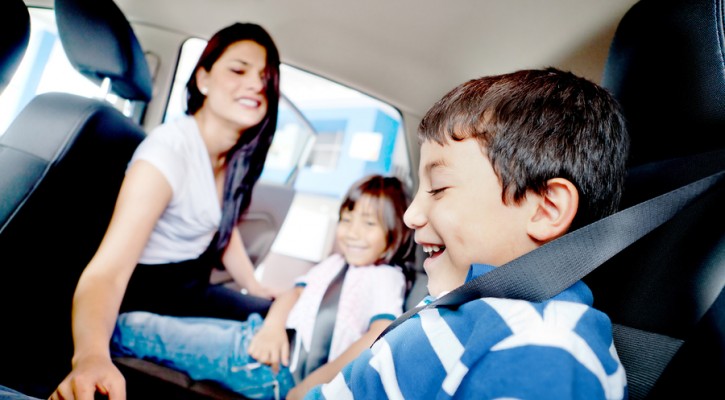
Ask The Traffic School Instructor: Pets In Cars
October 7, 2014
Question: Is it unsafe to drive with pets in cars?
Answer: It depends on how you transport the animal. Driving with unrestrained pets in a car can be dangerous for both you and the animal.
No matter how well trained an animal may be, they’re always unpredictable. It’s impossible to tell when something may be so enticing or frightening to an animal that it’s worth jumping out the window or clawing up the driver to escape. I’ll speak from a couple of my own experiences and hard learned lessons.
Many, many years ago we had a small terrier who used to accompany us when we ran errands or traveled. She had a lot of experience in the car and had never been a problem until one fateful day. We were traveling to a garden store that just happened to be across the street from her vet’s office. As soon as I turned the corner, even without looking out the window, she knew we were headed in the direction of the vet and she made a break for it by jumping out the open window into the middle of a very busy intersection. Fortunately, I was able to stop and other traffic cooperated by stopping long enough for me to catch her and get her safely back into the car.
On another occasion, we decided to get a kitten for our daughter. She had chosen a tiny kitten from a litter and we were on our way home on an interstate highway. So far, the sweet, tiny little kitten had remained very calm but, as I approached a toll booth, something spooked him. He raced right up my chest and dug his tiny, very sharp little claws into my face and held on for dear life. Luckily, there was very little traffic and I was already slowing for the toll booth. I had to steer with one hand and try to see around his body as I fought to rip his claws from my face. My three year old daughter thought it was hilarious.
If you’re the type of driver who likes to drive with pets in your lap, you might be heading for a big distraction if that pet wants to suddenly jump up and look out the window or try to escape. If a cat gets spooked in any way, you can count on being clawed as he tries to escape.
Even if the animal is calm and resting, if you have to suddenly hit the brakes, the animal is going to go flying into or under the dashboard; possibly interfering with your control of the gas and brake pedals. Depending on your speed at the time, it could lead to serious injuries for the animal.
Just like people, pets need to be restrained while in a car; either in a carrying case or by use of a halter designed to work with the seat belts. Now, when I travel out of state with my dog, she wears a travel harness and is clipped in to a D-ring in the cargo area behind the back seat. That’s the only way she has ever traveled. She’s used to it and remains very calm on our trips. It’s the best way to travel with a pet for both her safety and mine.

Ask The Traffic School Instructor: Emergency Flashers
October 1, 2014
Question: Should You use your emergency flashers when it is raining hard?
Answer: This is a common sight, especially in the South where heavy summer thunderstorms hit often. Driving with your emergency flashers on is not only illegal, it’s a really bad idea.
Emergency flashers are only supposed to be used on disabled vehicles to warn other drivers away. They can’t be used in the rain or to identify slow moving vehicles and there are good reasons for this.
Having personally witnessed multiple drivers using their flashers in heavy traffic during a rain storm, I can tell you it made it very confusing for me and, I’m sure, other drivers. The flashers made it hard to tell the difference between the vehicle’s emergency flashers and the brake lights. Determining when the brake lights came on was even more difficult because people tend to ignore the lights on a vehicle whose lights are continually flashing. It also makes it difficult to distinguish between a vehicle that is moving and one that may actually be disabled and stopped. With the lowered visibility due to the rain, the flashers just added to the hazards.
If it’s raining so hard that visibility is reduced to the point where you can’t see other traffic, drivers should pull off the road and wait until the storm passes. If you pull off the road and stop, then the emergency flashers can and should be used.
Using your emergency flashers to indicate that you are driving slower than other traffic is also illegal. Vehicles with mattresses tied to the roof with string or cars running on less than all cylinders don’t belong on the road. If you need to carry something that won’t fit inside your vehicle, you need to rent a trailer or a van. If your vehicle is unable, for whatever reason, to keep up with the flow of traffic, you should also stay off the road until the condition can be fixed.

Ask The Traffic School Instructor: Speed Limits
September 24, 2014
Question: Do speed limits reduce traffic accidents?
Answer: No, speed limits by themselves can’t save lives. However, drivers who obey the posted speed limits do save lives. Let’s look at the purpose of speed limits and then, at why speed is dangerous.
According to the National Highway Transportation Administration (NHTSA), approximately one-third of all highway traffic deaths are directly due to speeding. Speeding means either going faster than the posted speed limit or traveling too fast for conditions.
What’s the purpose of speed limits?
There’s a popular belief that speed limits are just a way for governments to raise income by handing out traffic tickets but that’s not the case. Speed limits are determined by traffic engineers and set by local or state governments. No one likes traffic jams so, when trying to determine a speed limit, traffic engineers are actually trying to determine the highest safe speed that will allow traffic to move freely. In order to do this, they have to look at a lot of factors including; size of the road, number of lanes, curves, hills, whether the roadway passes through a school zone, shopping district, etc.
Taking all of those factors into consideration, once a speed limit is set, it is the maximum speed allowed during ideal conditions. Ideal conditions mean clear visibility and dry roads. When there is heavy rain, snow or fog, it’s up to drivers to adjust their speed according to conditions. Even if a driver is traveling at or below the speed limit, it’s still possible to get a speeding ticket for driving too fast for conditions.
Why is speed a problem?
Reaction time
The higher the speed, the less time a driver has to react to an emergency situation ahead. It takes between 1 to 1.5 seconds for a driver to react to an emergency situation. That means a driver obeying a speed limit of 45 mph will travel approximately 99 feet before he or she can fully react. A driver traveling 10 mph over the speed limit will travel more than 121 feet in the same amount of time. A lot can happen in that amount of space.
Laws of Physics
The laws of physics come into play also. A basic law of motion states that an object in motion tends to remain in motion – in a straight line. A driver driving too fast in a curve stands a good chance of losing control and running off the roadway because, due to the laws of motion, it’s physically impossible to keep the vehicle on the road. Physics also come into play in a crash. The higher the speed, the greater the crash forces will be.
Reducing traffic Jams
Believe it or not, if everyone were to obey the speed limit and keep a safe following distance between their vehicle and the vehicle ahead, traffic would move much faster and more smoothly. Traffic jams are caused by drivers who are driving too fast and then hit the brakes when they approach a vehicle ahead. This causes traffic behind to hit the brakes and a traffic jam is the result.
You won’t get there any faster by speeding and yes, obeying the speed limit saves lives!

Ask The Traffic School Instructor: Reducing Traffic Jams
September 17, 2014
Question: What can be done to reduce traffic jams?
Answer: Traffic engineers are always looking for ways to reduce traffic jams but those solutions usually involve adding extra lanes or exits. If you live in a place where these types of road improvements have occurred, you’ve probably noticed that it didn’t take long for the traffic jams to return. It seems like adding extra lanes just draws more traffic but that actually isn’t the case.
Believe it or not, even with the same amount of traffic, individual drivers can make a big difference when it comes to reducing traffic jams. To do that, you first have to understand how traffic jams start. It’s not really the volume of traffic but the way people drive in those situations that create the traffic jams.
Traffic jams begin with what are known as traffic waves. Generally, a wave starts when a driver nears a slower driver ahead and hits his brakes. Once his brake lights come on, the driver behind hits her brakes and so on and so on and so on…… The driver in the front hasn’t been affected by the wave but traffic a quarter mile behind is now coming to a stop. This wave effect has also been compared to putting a kink in a water hose.
Traffic engineers understand this effect and, in some places, are trying to correct it in a way that sounds counter intuitive. In Atlanta and Washington State, traffic engineers are trying to prevent traffic jams through the use of variable speed limits on the interstate. By watching video monitors in a command center, when they see traffic waves start to build, they’ll adjust the speed limit via electronic speed limit signs. However, instead of increasing the speed, they’ll try to slow down the traffic behind. By slowing traffic behind, in some cases down to 35 mph, they hope that the wave ahead will have time to break up and move on. By allowing the wave time to break up, fewer cars behind will hit the brakes, causing an even longer wave. By slowing traffic, they hope to keep it moving instead of bringing it to a halt. Moving along at 35 mph is better than not moving at all. It’s too early to tell if it will work in Atlanta but it seems to be working quite well in Washington.
But we don’t have to wait for traffic engineers to solve the problem. Individual drivers can take action to stop traffic waves by simply allowing a longer following distance between them and the cars ahead. Even if traffic enters the lane ahead of you, if you back off slightly by taking your foot off the gas, you’ll notice that, while you may be going just a little bit slower, you’re still moving. It also has the effect of eliminating traffic waves behind you. If you try this, hopefully, you’ll find, just as the driver who created the video below has found, that a single driver can make a big difference when it comes to reducing traffic jams. Driving on the interstate isn’t a competition, it’s a cooperative effort!

Kids In Cars Put In Danger By Parents
September 16, 2014
One in five parents put kids in cars in danger by “bending the rules” according to a survey conducted by Safe Kids Worldwide and funded by the General Motors Foundation. In the online survey, parents admitted that, when carpooling, they sometimes bent the rules by allowing kids to ride without a booster seat or even without seat belts.
According to Safe Kids, “Sixty-one percent of parents say they notice other carpool drivers bending the rules. Safe Kids research also shows that one in four parents report they don’t buckle up their children on every ride.”
Even on a short trip, the dangers of a crash are high. Most car crashes happen within 25 miles of home and at speeds under 45 mph. The reason for that is simple; your chances of being involved in a crash close to home are greater because that’s where you drive most often.
School age children should be belted into a booster seat seat until they are big enough to wear a seat belt properly. Safety experts say that kids should remain in a booster seat until they are at least 4’7” tall and weigh between 80 and 100 pounds. For most kids that’s between 9 and 11 years of age.
According to the National Highway Transportation Safety Administration (NHTSA), motor vehicle crashes were the leading cause of death for children age 4 and every age 11 through 14. They are the second leading cause of death for ages 5 through 10. NHTSA data shows that, “among passenger vehicle occupants 5 and older, seat belts saved an estimated 12,174 lives in 2012. If all passenger vehicle occupants 5 and older had worn seat belts, 15,205 lives (that is, an additional 3,031) could have been saved in 2012.”
Even on short trips, kids in cars need to be buckled into a child safety seat appropriate for their age. Parents who carpool should never take more children than the number of seat belts available in the vehicle. Carpooling parents should also arrange to swap out car seats and booster seats.
Don’t place yourself in the position of a parent who says “If only I had….”
For more information, read: STUDY REVEALS 9 OUT OF 10 PARENTS MOVE THEIR CHILD FROM BOOSTER SEAT TO SEAT BELT BEFORE THEIR CHILD IS BIG ENOUGH
